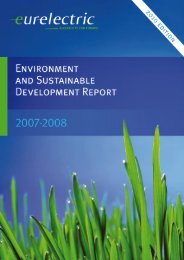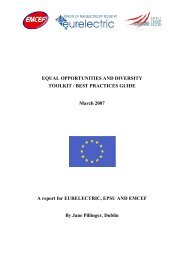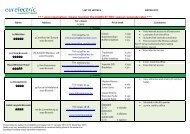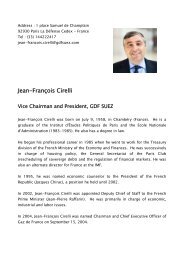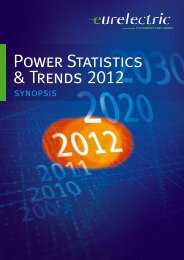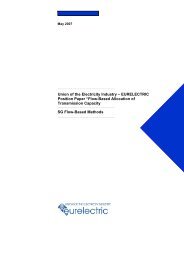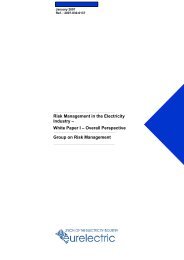The Role of Distribution System Operators (DSOs) as ... - Eurelectric
The Role of Distribution System Operators (DSOs) as ... - Eurelectric
The Role of Distribution System Operators (DSOs) as ... - Eurelectric
Create successful ePaper yourself
Turn your PDF publications into a flip-book with our unique Google optimized e-Paper software.
<strong>The</strong> <strong>Role</strong> <strong>of</strong> <strong>Distribution</strong> <strong>System</strong><br />
<strong>Operators</strong> (<strong>DSOs</strong>) <strong>as</strong> Information Hubs<br />
--------------------------------------------------------------------------------------------------<br />
A EURELECTRIC Networks Committee paper<br />
June 2010
<strong>The</strong> Union <strong>of</strong> the Electricity Industry–EURELECTRIC is the sector <strong>as</strong>sociation representing the<br />
common interests <strong>of</strong> the electricity industry at pan-European level, plus its affiliates and <strong>as</strong>sociates on<br />
several other continents.<br />
In line with its mission, EURELECTRIC seeks to contribute to the competitiveness <strong>of</strong> the electricity<br />
industry, to provide effective representation for the industry in public affairs, and to promote the role <strong>of</strong><br />
electricity both in the advancement <strong>of</strong> society and in helping provide solutions to the challenges <strong>of</strong><br />
sustainable development.<br />
EURELECTRIC’s formal opinions, policy positions and reports are formulated in Working Groups,<br />
composed <strong>of</strong> experts from the electricity industry, supervised by five Committees. This “structure <strong>of</strong><br />
expertise” ensures that EURELECTRIC’s published documents are b<strong>as</strong>ed on high-quality input with up-todate<br />
information.<br />
For further information on EURELECTRIC activities, visit our website, which provides general information<br />
on the <strong>as</strong>sociation and on policy issues relevant to the electricity industry; latest news <strong>of</strong> our activities;<br />
EURELECTRIC positions and statements; a publications catalogue listing EURELECTRIC reports; and<br />
information on our events and conferences.<br />
Dépôt légal: D/2010/12.205/17
<strong>The</strong> <strong>Role</strong> <strong>of</strong> <strong>Distribution</strong> <strong>System</strong> <strong>Operators</strong><br />
(<strong>DSOs</strong>) <strong>as</strong> Information Hubs<br />
--------------------------------------------------------------------------------------------------<br />
Working Group <strong>Distribution</strong> Customers and Operation<br />
Petter SANDOY (NO) Chair<br />
Robert BARICEVIC (HR); Heinrich BUSCH (DE); Peter COYLE (GB); Han J. DAMSTE (NL);<br />
Manuel DELGADO (ES); Vitor Tom<strong>as</strong> DORES (PT); Reinhard DRAXLER (AT); Michael<br />
GULDBAEK ARENTSEN (DK); Jacques HORVILLEUR (FR); Muhammed Mustafa IZGEC (TR);<br />
Christos KATSANOS (GR); Luk<strong>as</strong> KUENG (CH); Sigurd KVISTAD (NO); Riccardo LAMA (IT);<br />
Elina LEHTOMAKI (FI); Stanislav MOTEJZIK (CZ); Bo OLSSON (SE); Marian ONDREJKOVIC<br />
(SK); Gheorghe OPREA (RO); Piotr ORDYNA (PL); Mindaug<strong>as</strong> PAPECKYS (LT); Igor<br />
PODBELSEK (SI); Philippe SOMMEREYNS (BE)<br />
Contact:<br />
Pierre SCHLOSSER, Advisor Networks Unit<br />
pschlosser@eurelectric.org
Index<br />
1. Executive Summary........................................................................................................... 2<br />
2. Introduction ...................................................................................................................... 4<br />
3. <strong>The</strong> role <strong>of</strong> <strong>DSOs</strong> in achieving customer choice through competitive retail markets...... 5<br />
3.1 Towards competitive and integrated European retail markets.............................. 6<br />
3.2 <strong>DSOs</strong> <strong>as</strong> impartial and neutral facilitators <strong>of</strong> competitive markets ........................ 7<br />
4. EURELECTRIC’s Model for <strong>DSOs</strong> <strong>as</strong> Information Hubs...................................................... 9<br />
4.1 What information should be provided from the DSO and when?.......................... 9<br />
4.2 In which format should the information be exchanged?...................................... 10<br />
4.3 Finding a good balance between market facilitation and consumer’s<br />
confidentiality protection...................................................................................... 11<br />
5. Some examples <strong>of</strong> information hub models in Europe .................................................. 13<br />
5.1 Norway: <strong>The</strong> NUBIX Model.................................................................................... 13<br />
5.2 Sweden: the EMIX portal....................................................................................... 14<br />
5.3 France: the SGE Model .......................................................................................... 15<br />
5.4 Slovenia: the «Perun» Portal................................................................................. 16<br />
5.5 Czech Republic: Energy Market Operator (OTE) ................................................... 17<br />
6. Conclusions and Recommendations............................................................................... 19
1. Executive Summary<br />
European <strong>Distribution</strong> <strong>System</strong> <strong>Operators</strong> (<strong>DSOs</strong>) are facing new challenges. Besides their<br />
traditional mission to operate, maintain and develop an efficient electricity distribution<br />
system, European <strong>DSOs</strong> are <strong>as</strong>ked to fulfil a new role: facilitate effective and well-functioning<br />
retail markets. Effective retail markets are markets which should give options to the<br />
customers allowing them to choose the best supplier and should allow suppliers to <strong>of</strong>fer<br />
options and services best tailored to customer needs.<br />
In this new role <strong>as</strong> neutral market facilitators, <strong>DSOs</strong> are evolving towards information hubs<br />
to perform a reliable and swift change <strong>of</strong> supplier. In this paper, we highlight the key<br />
characteristics <strong>of</strong> what we understand <strong>as</strong> the role <strong>of</strong> <strong>DSOs</strong> <strong>as</strong> information hubs. We later<br />
explain how European <strong>DSOs</strong> are currently implementing new information hub solutions to<br />
facilitate switching. This new process represents a particular challenge, since with the advent<br />
<strong>of</strong> smart meters, the complexity <strong>of</strong> data handling incre<strong>as</strong>es.<br />
<strong>The</strong> support <strong>of</strong> policy makers is needed to accompany <strong>DSOs</strong>’ evolution towards information<br />
hubs:<br />
1. EURELECTRIC deems essential that market actors are able to use a common marketspecific<br />
communication and data management system. For this purpose, information<br />
requirements should be the same and a minimum level <strong>of</strong> information requirements<br />
should be specific: the datab<strong>as</strong>e format for example should be open and escalating<br />
so <strong>as</strong> to facilitate data exchange <strong>as</strong> well <strong>as</strong> data aggregation.<br />
2. EURELECTRIC considers that policy makers can <strong>as</strong>sist in promoting harmonisation and<br />
standardisation <strong>of</strong> data exchanges and customer processes at the European Union<br />
level <strong>as</strong> this would facilitate supplier switches. Furthermore, EURELECTRIC calls for<br />
compatible systems, rules and processes to ensure regional compatibility and interoperability<br />
<strong>of</strong> retail markets.<br />
3. Smart meters will help <strong>DSOs</strong> in their market facilitation t<strong>as</strong>k. EURELECTRIC<br />
recommends however that the functionality <strong>of</strong> any smart metering system should be<br />
determined by how it can improve customer service and retail functioning while at<br />
the same time keeping costs down.<br />
4. EURELECTRIC sees the need to allow for interoperability and product innovation <strong>of</strong><br />
smart meters. <strong>The</strong> meter should not be tied to any ‘proprietary standard’. As such, a<br />
high level <strong>of</strong> interoperability and minimum technical standards are necessary in order<br />
to allow electricity consumers, suppliers and <strong>DSOs</strong> to benefit from economies <strong>of</strong><br />
scope/ economies <strong>of</strong> scale and from innovation.<br />
5. EURELECTRIC accordingly underlines the need to separate the definition <strong>of</strong> information<br />
and processes from the technology used to implement efficient information exchanges.<br />
Flawless and efficient implementation <strong>of</strong> business requires the interoperability <strong>of</strong> the<br />
corresponding IT support infr<strong>as</strong>tructure to ensure simple, quick and reliable customer<br />
related processes.<br />
2
2. Introduction<br />
Electricity networks comprise both transmission infr<strong>as</strong>tructure and distribution<br />
infr<strong>as</strong>tructure. Although there is no <strong>of</strong>ficial or formal "rule" to differentiate between<br />
transmission and distribution lines, <strong>as</strong> a guide, we can say that transmission is all about<br />
moving large blocks <strong>of</strong> power around a country or region or between countries, from where<br />
it is produced to the area (such <strong>as</strong> a city) where it is consumed. This is typically carried out<br />
via larger scale power lines at higher voltage. <strong>Distribution</strong> is then about distributing and<br />
delivering this power to final customers, via smaller power lines at medium and/or lower<br />
voltage which form the distribution networks. <strong>The</strong>se are typically local infr<strong>as</strong>tructure, but<br />
can also comprise some low-voltage regional networks, for example in rural are<strong>as</strong>.<br />
From an economic perspective, electricity distribution is considered to be a "natural<br />
monopoly" activity, meaning that on this specific market segment one firm can produce a<br />
desired output at a lower social cost than two or more firms because <strong>of</strong> both high fixed costs<br />
and economies <strong>of</strong> scale. This explains why distribution tariffs are regulated by the national<br />
regulatory authorities, who define or approve the level <strong>of</strong> tariffs and/or pr<strong>of</strong>its that<br />
distributors are allowed to set/make. Requirements to separate these activities from the<br />
other segments <strong>of</strong> the electricity value chain (i.e. generation and supply activities) include<br />
legal provisions for separation at managerial, functional and legal level <strong>as</strong> set in articles 15-<br />
20 <strong>of</strong> the 2003/54/EC Directive “concerning common rules for the internal market in<br />
electricity” 1 .<br />
<strong>Distribution</strong> companies have the responsibility to deliver energy <strong>of</strong> suppliers to end-users<br />
and to maintain the distribution networks. <strong>The</strong>y are hence particularly important in ensuring<br />
faultless delivery <strong>of</strong> electrical power to the end users.<br />
In addition, <strong>as</strong> each and every electricity customer h<strong>as</strong> the right to choose his/her supplier in<br />
the competitive market, the distribution companies together with suppliers must work out<br />
practicable solutions for information exchange on large numbers <strong>of</strong> customers wishing to<br />
switch from one supplier to another, also because overall European <strong>DSOs</strong> remain key players<br />
in the activity <strong>of</strong> metering the electricity flow to customers.<br />
As such, <strong>DSOs</strong> have a key role to play in enabling competitive retail markets in Europe<br />
among others by facilitating transparent and non-discriminatory access to network and<br />
customer information.<br />
1 <strong>The</strong> same Directive’s article 13 imposes Member States to “designate or […] require undertakings that own or<br />
are responsible for distributions systems to designate […] one or more <strong>Distribution</strong> <strong>System</strong> <strong>Operators</strong><br />
(<strong>DSOs</strong>)”Ever since the adoption <strong>of</strong> this Directive, the acronym “DSO” h<strong>as</strong> become commonly used among<br />
policymakers and stakeholders and this paper will not derogate to this rule.<br />
4
However, an incre<strong>as</strong>ing amount <strong>of</strong> supplier-switches will pose challenges to <strong>DSOs</strong> if they<br />
want to keep playing their role <strong>of</strong> market facilitation. To exploit new functionalities in<br />
customer systems, investments in IT systems and customer service resources should be<br />
carried out. To finance them, <strong>DSOs</strong> should be allowed to have adequate returns to recover<br />
the investment and related operational expenditure. In this way, <strong>DSOs</strong> could contribute, at<br />
the level <strong>of</strong> their ambition, to the on-going development <strong>of</strong> well-functioning and competitive<br />
electricity retail markets.<br />
As many observers - including EURELECTRIC - recognize, there is a real need to develop<br />
competitive and well-functioning retail markets in Europe in order to make customers gain<br />
from benefits in terms <strong>of</strong> prices, quality <strong>of</strong> services, choice <strong>of</strong> commercial <strong>of</strong>fers and product<br />
innovation.<br />
Taking into account existing papers on retail markets and customer protection by regulatory<br />
bodies, the European Commission <strong>as</strong> well <strong>as</strong> EURELECTRIC, this paper aims at clarifying the<br />
roles and responsibilities <strong>of</strong> <strong>Distribution</strong> <strong>System</strong> <strong>Operators</strong> (<strong>DSOs</strong>) in the ways towards<br />
achieving greater customer choice on the electricity retail markets.<br />
3. <strong>The</strong> role <strong>of</strong> <strong>DSOs</strong> in achieving customer choice through competitive retail<br />
markets<br />
When discussing the ways towards reaching competitive and integrated European electricity<br />
retail markets in the future, European <strong>DSOs</strong> should be seen <strong>as</strong> key stakeholders in the<br />
liberalisation process, along with suppliers, customers and regulators. As market facilitators,<br />
<strong>DSOs</strong> are indeed at the forefront when it comes to enhancing competition.<br />
Regulators<br />
<strong>DSOs</strong><br />
Customer<br />
Choice<br />
Suppliers<br />
Figure 1: Mapping <strong>of</strong> the key actors involved in driving retail market competition for incre<strong>as</strong>ed customer choice<br />
5<br />
Customers
3.1 Towards competitive and integrated European retail markets<br />
Under competitive and integrated retail markets, we understand retail market designs which<br />
bring benefits to customers in terms <strong>of</strong> prices, quality <strong>of</strong> services, choice <strong>of</strong> commercial<br />
<strong>of</strong>fers and product innovation. In our view, a competitive market design is the main vehicle<br />
through which these consumer benefits can be achieved.<br />
In a p<strong>as</strong>t publication 2 , EURELECTRIC h<strong>as</strong> stressed that for competition to develop on retail<br />
markets, they should have a certain optimal design that would include following features,<br />
summarized in our Reference Retail Market Model:<br />
1. A strong link to an efficient and liquid wholesale market for procurement and balancing<br />
2. Market entry facilitation<br />
3. A clear definition <strong>of</strong> market players’ role<br />
4. <strong>The</strong> guarantee that all market players have access to the same set <strong>of</strong> critical information<br />
and that customers have e<strong>as</strong>y access to information on suppliers, prices and terms<br />
5. A sufficient harmonisation and efficient organisation <strong>of</strong> b<strong>as</strong>ic information requirements<br />
and business processes, so that proper implementation and data exchange between<br />
market participants; including appropriate control and audit <strong>of</strong> these processes and data<br />
exchanges<br />
6. Simple and reliable switching processes which do not entail excessive costs for<br />
customers and suppliers<br />
7. An open governance structure is in place that leaves room for market participants in<br />
shaping the processes through which information should flow<br />
<strong>The</strong> development <strong>of</strong> retail market integration, expected to benefit consumers, suppliers and<br />
the society <strong>as</strong> a whole, needs commitment <strong>of</strong> market players and facilitators since<br />
compatibility and inter-operability will not happen by itself.<br />
So far, retail market designs remain indeed national. As a matter <strong>of</strong> fact, it is only possible to<br />
enter the market <strong>of</strong> another Member State by investing in country-specific systems and<br />
processes. To push for a regional integration <strong>of</strong> retail markets in a first stage and a pan-<br />
European integration <strong>of</strong> retail market in a second stage, core elements <strong>of</strong> national retail<br />
market designs should be compatible with each other and various business to business and<br />
business to customers processes should be interoperable.<br />
Otherwise, new entry in electricity retail markets will be hampered by the fact that specific<br />
and costly applications are needed due to diverging market designs, rules and processes.<br />
This will result in a suboptimal level <strong>of</strong> competition on the electricity retail markets.<br />
<strong>The</strong>refore requirements for the interoperability and possible integration <strong>of</strong> retail markets<br />
should be set. This does not mean that retail markets should be fully harmonised; it simply<br />
signifies that the various national markets should have common features so <strong>as</strong> to promote<br />
competition, lower entry barriers and facilitate integration in the future. As major market<br />
facilitators, <strong>DSOs</strong> have a role to play in enhancing competition on the retail markets.<br />
2<br />
EURELECTRIC Reference ‘Retail Market Model’: Bringing the Benefits <strong>of</strong> Competitive Electricity Markets to the<br />
Customer, WG Retail Markets, April 2007.<br />
6
3.2 <strong>DSOs</strong> <strong>as</strong> impartial and neutral facilitators <strong>of</strong> competitive markets<br />
In order for electricity retail markets to function properly and to allow for greater customer<br />
choice, <strong>DSOs</strong>’ transparent and neutral role will be essential. <strong>The</strong> Second Electricity Directive<br />
h<strong>as</strong> made clear that <strong>DSOs</strong>’ t<strong>as</strong>ks w<strong>as</strong> to “maintain a secure, reliable and efficient electricity<br />
distribution system” not to participate in the retail market by “discriminating between<br />
systems users or cl<strong>as</strong>ses <strong>of</strong> system users, particularly in favour <strong>of</strong> its related undertakings” 3 .<br />
Accordingly, <strong>DSOs</strong>’ role is to facilitate the market, not participate in it. This is especially valid<br />
when managing metering, providing information to market participants and smoothing the<br />
process <strong>of</strong> changing supplier.<br />
METERING<br />
ACCESS TO<br />
CUSTOMER INFORMATION<br />
CHANGE OF<br />
SUPPLIER<br />
MARKET<br />
FACILITATION<br />
CUSTOMER<br />
CHOICE<br />
Figure 2: <strong>The</strong> three channels through which <strong>DSOs</strong> facilitate competitive markets<br />
Hence, <strong>DSOs</strong> can contribute to the wider objective <strong>of</strong> achieving competitive and integrated<br />
European electricity retail markets in two broad ways:<br />
(1) By being proactive in helping achieving the lifting <strong>of</strong> operational and technical<br />
barriers which currently hamper the development <strong>of</strong> competitive retail markets.<br />
Entry for a supplier into different retail markets can indeed be greatly facilitated if<br />
compatible data models are used and if b<strong>as</strong>ic business processes can be implemented in the<br />
same way, i.e. via harmonisation. In particular, processes related to <strong>DSOs</strong>, metering and<br />
supplier switching and other key supplier processes should be considered for progressive<br />
harmonisation. Equally, European <strong>DSOs</strong> should move towards a unique identification <strong>of</strong><br />
metering points to facilitate data exchanges.<br />
3 Art. 14 : Directive 2003/54/EC <strong>of</strong> the European Parliament and <strong>of</strong> the Council <strong>of</strong> 26 June 2003 concerning<br />
common rules for the internal market in electricity and repealing Directive 96/92/EC<br />
7
Nevertheless, well-defined information requirements and well-defined processes are<br />
unlikely to emerge without standardised information requirements. And yet, in a<br />
competitive retail market, market actors must be able to use a common market-specific<br />
communication and data management system. Thus, information requirement should be the<br />
same and a minimum level <strong>of</strong> information requirements should be specific: among the most<br />
important pieces <strong>of</strong> information are the identification <strong>of</strong> the metering point, energy usage<br />
data and customer information.<br />
(2) By being reliable and transparent service providers to both suppliers and<br />
customers, granting access to network and consumption information to all market<br />
players – including new entrants - without distinction<br />
In this regard, the Second Electricity Directive states clearly that “the <strong>Distribution</strong> <strong>System</strong><br />
Operator shall provide system users with the information they need for efficient access to<br />
the system” 4 .<br />
Currently, the different supplier switching models in Europe include variations on the role <strong>of</strong><br />
market participants <strong>as</strong> well <strong>as</strong> in the format <strong>of</strong> various business to business and business to<br />
consumer processes. This means that it is only possible to enter the market <strong>of</strong> another<br />
Member State by investing in country-specific infr<strong>as</strong>tructure systems and processes.<br />
Regional market integration, <strong>as</strong> first stage towards a common electricity market, implies that<br />
integrated national retail markets should be compatible. However this compatibility and/or<br />
interoperability will not happen by itself; all parties including market actors, regulators,<br />
governments, the European Commission and also customers should play an active role in<br />
ensuring that compatible systems, rules and processes are put in place. <strong>The</strong> section below<br />
will show in further detail what kind <strong>of</strong> information EURELECTRIC believes <strong>DSOs</strong> should<br />
provide to suppliers and customers, when this information should flow and in what format.<br />
4 Art. 14 § 4: Directive 2003/54/EC <strong>of</strong> the European Parliament and <strong>of</strong> the Council <strong>of</strong> 26 June 2003 concerning<br />
common rules for the internal market in electricity and repealing Directive 96/92/EC<br />
8
4. EURELECTRIC Model for <strong>DSOs</strong> <strong>as</strong> Information Hubs<br />
On the b<strong>as</strong>is <strong>of</strong> the various scenarios under which customers and/or suppliers will turn to<br />
<strong>DSOs</strong> to access relevant information, we have developed an information hub model which<br />
summarizes (4.1) the information which should be provided by the DSO and when, (4.2) the<br />
format in which the data should be exchanged and (4.3) the need to strike a fair balance in<br />
this process, between market facilitation and the safeguard <strong>of</strong> consumer confidentiality.<br />
4.1 What information should be provided from the DSO and when?<br />
Depending on the situation, the DSO will have to provide information to the suppliers<br />
involved in the process (4.1.1) and to the consumers (4.1.2).<br />
4.1.1 Information to the suppliers<br />
When <strong>DSOs</strong> are responsible for managing customer and consumption information, they<br />
should share this information with relevant market players in a timely and efficient manner.<br />
This is true in particular for suppliers, <strong>as</strong> it improves their ability to calculate quot<strong>as</strong> and<br />
target consumers with the most appropriate products. However they should at the same<br />
time maintain the necessary level <strong>of</strong> confidentiality.<br />
<strong>The</strong> information sent to the suppliers is market information on the consumers’ data that<br />
<strong>DSOs</strong> have to facilitate in order to improve competition among suppliers. In a competitive<br />
retail market, market actors must be able to use a common market-specific communication<br />
and data management system. For this purpose, information requirements should be the<br />
same and a minimum level <strong>of</strong> information requirements should be specific. <strong>The</strong> datab<strong>as</strong>e<br />
format would be open and escalating so <strong>as</strong> to facilitate data exchange <strong>as</strong> well <strong>as</strong> data<br />
aggregation. It might include the following information:<br />
• Personal Consumer Data (Name, Address)<br />
• Consumption site info (Metering point ID, meter type, meter number, pr<strong>of</strong>ile cl<strong>as</strong>s<br />
etc)<br />
• Consumption Data (Yearly, Monthly, Hourly consumption)<br />
<strong>DSOs</strong> should provide suppliers concerned by the switching with all data related to the<br />
customer. Provided that the customer explicitly agrees, his data can be sent directly to the<br />
chosen supplier by the DSO. This enables the supplier to reduce uncertainty in the price<br />
calculation which in sum makes the <strong>of</strong>fer more competitive. <strong>The</strong>refore the DSO should<br />
attribute to each metering point a clear identification number so that an e<strong>as</strong>y and f<strong>as</strong>t data<br />
exchange is facilitated.<br />
9
4.1.2 Information to the consumers<br />
For me<strong>as</strong>ures <strong>of</strong> simplification, one contact point could be established with the supplier.<br />
When establishing the connection, the <strong>DSOs</strong> would send information to the customer only<br />
related to the performance <strong>of</strong> the network duties (connection, end-usage contract/terms,<br />
network tariffs, metering service etc.). This would include contact details <strong>of</strong> suppliers (or a<br />
link to a national site regarding suppliers) and information following the Commission’s<br />
European Consumer Checklist.<br />
However, on every piece <strong>of</strong> communication (like invoices), the suppliers must provide its<br />
customer with an emergency contact <strong>of</strong> the DSO (in the event <strong>of</strong> disruption <strong>of</strong> energy<br />
supply) e.g. the metering point number and the meter identification number.<br />
4.2 In which format should the information be exchanged?<br />
Scenario 1: In the c<strong>as</strong>e <strong>of</strong> a supplier switching<br />
When the customer would like to switch supplier, he should get in contact with a supplier<br />
and should ideally have no interface with the DSO. If the customers reaches his DSO, he<br />
should be informed on: <strong>The</strong> need <strong>of</strong> contacting a supplier (<strong>as</strong> to where to find information)<br />
and make a contract with the supplier <strong>of</strong> choice. During the supply switch, <strong>as</strong> suppliers<br />
exchange data, no additional information is needed to be transferred from the DSO directly<br />
to the consumer 5 .<br />
Scenario 2: In the c<strong>as</strong>e <strong>of</strong> a first connection<br />
When the customer moves to a house or a flat that h<strong>as</strong> not been connected to the<br />
network before, the DSO should neutrally inform the customer on:<br />
• <strong>The</strong> electricity suppliers available in the customer area<br />
• <strong>The</strong> right to access the network<br />
• <strong>The</strong> time for initial connection<br />
• <strong>The</strong> price to establish connection<br />
• <strong>The</strong> connection charges (depending whether it is paid directly or through the<br />
supplier)<br />
• <strong>The</strong> network tariffs<br />
• <strong>The</strong> meter Point Reference number<br />
• <strong>The</strong> network access contract conditions<br />
• <strong>The</strong> metering services<br />
• <strong>The</strong> contact in the event <strong>of</strong> disruption <strong>of</strong> energy supply<br />
• <strong>The</strong> importance <strong>of</strong> signing a supply contract<br />
• <strong>The</strong> procedure for customer claims<br />
Scenario 3: When a customer moves from one house to another<br />
<strong>The</strong> same logic <strong>as</strong> in the c<strong>as</strong>e <strong>of</strong> a supplier switch should apply. <strong>The</strong> customer should contact<br />
his supplier. To facilitate this process, there is a need to know the characteristics <strong>of</strong> the<br />
delivery point.<br />
5 However, national regulation still differs on some <strong>of</strong> these elements.<br />
10
In a liberalized retail market, network operators and other service providers must be able to<br />
interact with, and provide services for several supply companies. A well-functioning retail<br />
market should ensure that the related business and customer processes are carried out<br />
reliably and swiftly. This requires in turn clear operational and organisational rules <strong>as</strong> the<br />
processes necessitate a very high level <strong>of</strong> coordination between actors including data format<br />
standards across national regions and Europe.<br />
Information technology plays a key role in the implementation <strong>of</strong> the change <strong>of</strong> supplier. It<br />
is, however, important to separate the definition <strong>of</strong> information and processes from the<br />
technology used to implement efficient information exchanges. This is important because<br />
new technologies are currently developing and it should be possible to make use <strong>of</strong> new and<br />
more efficient technologies without having to remodel the process. Flawless and efficient<br />
implementation <strong>of</strong> business requires the interoperability <strong>of</strong> the corresponding IT support<br />
infr<strong>as</strong>tructure to ensure simple, quick and reliable customer related processes. In this way,<br />
customers can be confident about exercising their right to choose their supplier and that this<br />
switch will have positive effects on their electricity supply or bill without any risk.<br />
4.3 Finding a good balance between market facilitation and consumer’s confidentiality<br />
protection<br />
With the incre<strong>as</strong>ed number <strong>of</strong> supplier switches to be foreseen in the future, clear and<br />
harmonised rules that regulate consumer data access will need to be defined. So far, legal<br />
Aspects on Consumer Data Protection are defined by Directive 95/46/EC. <strong>The</strong> principle set<br />
out for making data access legitimate is unambiguous customer consent. However, the<br />
question raised h<strong>as</strong> rather to do with the access to data by Third Parties, once the customer<br />
agreed to give a party data access. <strong>The</strong> challenge is then to reconcile automated processing<br />
and free movement <strong>of</strong> data with the “unambiguous customer consent principle”.<br />
To clarify this <strong>as</strong>pect, European Member States have adopted various national legislations in<br />
order to define the access to customer data. Considering that access to customer data<br />
represents a serious barrier to market entry for electricity retail market suppliers, each<br />
legislation regulating the access <strong>of</strong> (registered) third parties must be seen <strong>as</strong> a trade-<strong>of</strong>f<br />
between the facilitation <strong>of</strong> access to market information (i.e. making retail markets more<br />
competitive) and the protection <strong>of</strong> consumer data confidentiality. As an example, a look at<br />
the Iberian Market gives more insight into the implications <strong>of</strong> this trade-<strong>of</strong>f.<br />
In Portugal, Law n°67/98 on protection <strong>of</strong> personal data makes a written consent provided<br />
by the consumer mandatory, being even auditable. Further requirements to access<br />
consumer data are (1) a point <strong>of</strong> supply code and (2) a supply contract reference number.<br />
<strong>The</strong> DSO <strong>as</strong> datab<strong>as</strong>e controller must therefore comply with this law and h<strong>as</strong> an explicit<br />
obligation to protect consumer data. In a nutshell: the Portuguese approach is very<br />
consumer protective.<br />
In Spain, access to customer data is more e<strong>as</strong>ily facilitated. Registered suppliers are free to<br />
access customer data and they are not subject to any previous requirement such <strong>as</strong> a point<br />
<strong>of</strong> supply code or a contract reference number. Access is consequently conducted through IT<br />
11
systems, by selecting data categories. However, consumers can deny access to their data<br />
with a written objection. <strong>The</strong> Spanish approach can therefore be seen <strong>as</strong> more market<br />
facilitative.<br />
Taking up the challenge <strong>of</strong> smart metering:<br />
Smart Metering is a very promising technology that can substantially empower electricity<br />
customers to become active managers <strong>of</strong> their consumption. Smart Meters will improve<br />
(through accurate billing) the customer’s knowledge about his/her electricity consumption<br />
thereby incre<strong>as</strong>ing customer awareness <strong>of</strong> energy end-use. Besides, Smart Meters will allow<br />
an optimization <strong>of</strong> the customer processes, making them more efficient and more reliable<br />
thereby leading to enhanced supplier switching and higher customer satisfaction. L<strong>as</strong>tly,<br />
Smart Meters will lead to an optimization <strong>of</strong> the overall electricity distribution infr<strong>as</strong>tructure.<br />
<strong>The</strong> expected large-scale deployment <strong>of</strong> smart meters in many EU Member States will<br />
enable both suppliers and <strong>DSOs</strong> to use more accurate individual consumption data (load<br />
pr<strong>of</strong>iles) in their processes. Smart Meters will indeed lead to enhanced demand-side<br />
management for household customers, in particular through the possibility <strong>of</strong> direct<br />
feedback and dynamic pricing opportunities.<br />
However, because <strong>of</strong> the high cost and organisational challenge <strong>of</strong> large-scale introduction<br />
<strong>of</strong> smart meters, it is very important to carefully <strong>as</strong>sess how smart metering should be<br />
introduced, under what conditions and with which specifications. <strong>DSOs</strong> must be prepared to<br />
handle the expected amount <strong>of</strong> data and to exchange it with suppliers. <strong>The</strong>re should be<br />
some agreement at European level on selected <strong>as</strong>pects <strong>of</strong> smart meter framework, at le<strong>as</strong>t<br />
on a ‘guiding principles’ b<strong>as</strong>is.<br />
Key considerations to be taken into account in this respect are 6 :<br />
• Firstly, the functionality <strong>of</strong> any smart metering system should be determined by how<br />
it can improve customer service and retail functioning while at the same time<br />
keeping costs down. This principle implicitly recognizes that this new technology is a<br />
means toward improvement and is not an end in itself.<br />
• Secondly, although any business c<strong>as</strong>e with regard to large-scale introduction <strong>of</strong><br />
smart metering depends largely on national characteristics, EURELECTRIC believes<br />
that smart metering solutions should be introduced in any national market in a<br />
manner which contributes to the development <strong>of</strong> compatible European retail<br />
markets.<br />
• A third factor is the need to reconcile mandating smart metering with (voluntary)<br />
customer choice. Any policy maker considering the mandatory introduction <strong>of</strong> smart<br />
metering should impartially separate those benefits and costs which accrue to all<br />
customers from those which only accrue to certain customer groups. EURELECTRIC<br />
6 <strong>The</strong>se issues have been extensively developed in EURELECTRIC’s position paper “Building a European Smart<br />
Metering Framework suitable for all Retail Electricity Customers” (May 2008).<br />
12
accordingly considers that only essential functionalities should be put in the general<br />
roll out mandate. Moreover, <strong>DSOs</strong> or other concerned market operators should be<br />
allowed to p<strong>as</strong>s-through the net costs <strong>of</strong> smart metering systems to these electricity<br />
consumer groups in a transparent and proportionate way.<br />
• A fourth defining element is the need to allow for interoperability and product<br />
innovation. <strong>The</strong> meter should not be tied to any ‘proprietary standard’. As such, a<br />
high level <strong>of</strong> interoperability and minimum technical standards are necessary in<br />
order to allow electricity consumers, suppliers and <strong>DSOs</strong> to benefit from economies<br />
<strong>of</strong> scope/ economies <strong>of</strong> scale and from innovation.<br />
5. Some examples <strong>of</strong> information hub models in Europe<br />
In order to facilitate supplier switches to the benefit <strong>of</strong> customers, European <strong>DSOs</strong> are<br />
incre<strong>as</strong>ingly developing data hub solutions. We selected 5 examples <strong>of</strong> these new systems<br />
also called “information hubs”.<br />
5.1 Norway: <strong>The</strong> NUBIX Model<br />
In the p<strong>as</strong>t, an inadequate set <strong>of</strong> rules defined how network owners and power suppliers<br />
governed data handling during the supplier switch process and created faults due to<br />
insufficient data. <strong>The</strong> need for common procedures and business rules w<strong>as</strong> identified to<br />
cover both the entire electricity supply business and the entire meter reading value chain.<br />
An independent body w<strong>as</strong> therefore considered by the industry <strong>as</strong> an efficient means to<br />
implement and facilitate the creation <strong>of</strong> efficient message interface and exchange, in<br />
particular during the supplier switch process.<br />
This discussion ushered in the creation <strong>of</strong> NUBIX (Norwegian Utilities Business Information<br />
Exchange) which is mainly a distributed solution for metering point ID search. It is<br />
implemented <strong>as</strong> a Web service and suppliers can implement NUBIX into their own ITsolutions.<br />
<strong>The</strong> NUBIX routes the query to the correct DSO, groups the answers, and delivers<br />
the answers back to the correct supplier. As such, it places the responsibility for<br />
administration <strong>of</strong> m<strong>as</strong>ter data where it belongs; the DSO, instead <strong>of</strong> in a central datab<strong>as</strong>e.<br />
<strong>The</strong> solution requires that the DSO implement a web service, between the Customer<br />
Information <strong>System</strong> and NUBIX.<br />
As an example, NUBIX handled 1.5 million requests in 2008. Given its success, the Norwegian<br />
energy regulator (NVE) decided to follow up and sanction <strong>DSOs</strong> which are not complying<br />
with NUBIX. As a result, after the 3 first months approximately 75 % <strong>of</strong> <strong>DSOs</strong> were<br />
compliant, after 9 first months approximately 90% <strong>of</strong> <strong>DSOs</strong> were compliant and by end <strong>of</strong><br />
2009 almost 100 % <strong>of</strong> <strong>DSOs</strong> were compliant. Functional changes are now being considered.<br />
13
Supplier N<br />
Supplier A<br />
Supplier B<br />
Prodat (Z03)<br />
Supplier switching<br />
DSO A<br />
DSO B<br />
DSO N<br />
5.2 Sweden: the EMIX portal<br />
XML<br />
XML<br />
NUBIX<br />
(web-service)<br />
XML<br />
14<br />
Ediel<br />
Portal<br />
Coupling <strong>of</strong><br />
post code and<br />
DSO<br />
Figure 3: Norway’s Nubix information portal<br />
Request:<br />
Post code<br />
+2 field e.g.:<br />
Name<br />
Date <strong>of</strong> Birth<br />
XML<br />
Answer:<br />
Metering point ID<br />
Prodat data<br />
+ other<br />
information<br />
Sweden’s EMIX portal started <strong>as</strong> a proactive industry initiative and is run by a limited<br />
company established precisely for this purpose. This company is 100% owned by<br />
Swedenergy and “independent suppliers” are also represented in the board. <strong>The</strong> limited<br />
company is financed by some <strong>of</strong> the companies and Swedenergy. Its letter <strong>of</strong> intent indicates<br />
that it covers 70% <strong>of</strong> the end customer market. <strong>The</strong> Swedish regulator and Swedish<br />
government support the initiative.<br />
However, EMIX is optional, not mandatory. Participation works through agreements with<br />
each distributor/supplier. <strong>The</strong> objective set by EMIX is to cover 100 % <strong>of</strong> the market by 2010.<br />
Currently, it is developing new services. It is recognised that EMIX enables an effective and<br />
simple integration and gradual transition to an open end-user market in the Nordic<br />
region/EU.<br />
DISTRIBUTOR<br />
SUPPLIER<br />
AGENT<br />
SUPPLIER<br />
EMIX will serves players in the industry<br />
SUPPLIER/<br />
DISTRIBUTOR<br />
AGENT<br />
~ 130 Electricity suppliers<br />
SUPPLIER<br />
DISTRIBUTOR<br />
DISTRIBUTOR<br />
DISTRIBUTOR<br />
SUPPLIER<br />
DISTRIBUTOR<br />
DISTRIBUTOR<br />
SUPPLIER<br />
AGENT<br />
DISTRIBUTOR<br />
SUPPLIER<br />
DISTRIBUTOR<br />
~ 185 Electricity distributors<br />
Today With EMIX<br />
Figure 4: Sweden’s EMIX information portal<br />
SUPPLIER<br />
DISTRIBUTOR
5.3 France: the SGE Model<br />
Thanks to ERDF’s SGE Information Hub, data flows are facilitated during the switching<br />
process. While using the web portal, suppliers can have access to customers’ information<br />
such <strong>as</strong>: address, meter technical data, etc. However, the former contract must be cancelled<br />
or a new contract must have been signed before the former contractual power is available.<br />
Moreover, the monthly average consumption is available, only if a new contract h<strong>as</strong> been<br />
signed.<br />
Figure 5: ERDF’s SGE information portal<br />
Customer<br />
Order<br />
ERDF IT applications<br />
15<br />
Supplier<br />
SGE<br />
Billing<br />
CRM<br />
Contracts data<br />
Consumptions<br />
Metering<br />
Interventions
5.4 Slovenia: the «Perun» Portal<br />
<strong>The</strong> PERUN internet portal administered by the DSO w<strong>as</strong> designed in 2005 and is – in<br />
Slovenia –intended for providing support to the process <strong>of</strong> changing a supplier for the<br />
suppliers <strong>of</strong> electricity where<strong>as</strong> all the authorised participants in the market (DSO<br />
contractors, regulator, market organiser and suppliers) may also exchange other information<br />
in one place.<br />
Key technical features <strong>of</strong> the portal:<br />
<strong>The</strong> Intranet part is intended for the providers <strong>of</strong> DSO activities in Slovenia; there are five<br />
distribution companies (Elektro Ljubljana d.d., Elektro Maribor d.d., Elektro Celje d.d.,<br />
Elektro Primorska d.d., Elektro Gorenjska d.d.), which operate, independently yet under the<br />
same terms and conditions.<br />
<strong>The</strong> Internet part is intended primarily for the suppliers <strong>of</strong> electrical energy pursuant to the<br />
principle <strong>of</strong> single entry point for all the suppliers <strong>of</strong> electrical energy in Slovenia.<br />
It is also intended for data exchange between other participants in the electricity market, i.e.<br />
the Energy Agency, BORZEN (Power Market Operator), the Ministry <strong>of</strong> the Economy, etc.<br />
Distributor 1<br />
Supplier 1<br />
Distributor 2<br />
Supplier 2<br />
Distributor 3<br />
Supplier 3<br />
Distributor 4<br />
Supplier 4<br />
Distributor 5<br />
Supplier 5<br />
16<br />
DSO<br />
Portal<br />
PERUN<br />
Figure 6: PERUN Internet Portal<br />
BORZEN<br />
Power Market<br />
Operator<br />
Energy Agency<br />
<strong>of</strong> Slovenia<br />
Supplier A<br />
Supplier B<br />
Supplier C<br />
Supplier n
An advantage for all its users is that PERUN is simple to use. It works with common browser<br />
tools and uses simple data and document transfer formats. It proves extremely trouble-free<br />
for limited number <strong>of</strong> metering points, data and documents.<br />
<strong>The</strong> PERUN internet portal is thus intended for daily data exchange among the providers <strong>of</strong><br />
<strong>DSOs</strong>’ activities, suppliers <strong>of</strong> electrical energy and other regulated players in the electricity<br />
market.<br />
5.5 Czech Republic: Energy Market Operator (OTE)<br />
Since January 1, 2006 each retail customer can freely choose their energy supplier. <strong>The</strong><br />
Czech energy regulatory body (ERU) provides information on all registered suppliers and<br />
<strong>DSOs</strong>. Customers can calculate their future costs and choose the best suitable solution. <strong>The</strong><br />
total sum for electricity consumption consists <strong>of</strong> regulated part (transport <strong>of</strong> energy from<br />
producer to final customer, i.e. distribution, system services, support <strong>of</strong> RES production,<br />
combined heat and power generation and secondary sources) and non-regulated part<br />
(power energy).<br />
In c<strong>as</strong>e <strong>of</strong> the first connection, the customer contacts the local DSO, grid owner and<br />
operator. In the application, the customer provides the DSO with all necessary data (name,<br />
contacts, address <strong>of</strong> point <strong>of</strong> consumption, planned volume <strong>of</strong> installed kW). <strong>The</strong> DSO<br />
registers the customers´ data (and data <strong>of</strong> point <strong>of</strong> consumption) in the system <strong>of</strong> energy<br />
market operator (OTE), which is necessary for evidence <strong>of</strong> the future trades <strong>of</strong> this customer.<br />
<strong>The</strong> DSO is responsible for data reading, processing and archiving.<br />
Following this, the DSO states the technical conditions <strong>of</strong> the first connection to the grid.<br />
Finally, after fulfilment <strong>of</strong> all requirements, the customer chooses the energy supplier. This is<br />
the two contracts solution: one contract for connection and distribution and one for power<br />
consumption. Another scenario is the combined contract, signed with supplier, covers both,<br />
distribution and power supply. In c<strong>as</strong>e <strong>of</strong> change <strong>of</strong> supplier the customer must terminate<br />
(b<strong>as</strong>ed on the settled conditions) the contract with the existing supplier in advance, at le<strong>as</strong>t<br />
before the date the new contracts become valid.<br />
17
DSO N<br />
DSO B<br />
LEGAL MARKET MODEL – DATA FLOW<br />
DSO A<br />
TSO<br />
RED - Volume <strong>of</strong> trading and purch<strong>as</strong>ing GREEN - Me<strong>as</strong>ured data (consumption, period)<br />
BLACK - Me<strong>as</strong>ured data <strong>of</strong> end customers CYAN - Registered market participants<br />
18<br />
Producer<br />
Energy Market Operator (OTE)<br />
Customer<br />
Supplier
6. Conclusions and Recommendations<br />
Besides their traditional mission to operate, maintain and develop an efficient electricity<br />
distribution system, European <strong>Distribution</strong> <strong>System</strong> <strong>Operators</strong> (<strong>DSOs</strong>) must fulfil a new role: to<br />
facilitate effective and well-functioning retail markets. Effective retail markets are markets which<br />
should give options to the customers allowing them to choose the best supplier and should<br />
allow suppliers to <strong>of</strong>fer options and services best tailored to customer needs.<br />
In this new role <strong>as</strong> neutral market facilitators, <strong>DSOs</strong> will be incre<strong>as</strong>ingly <strong>as</strong>ked to work <strong>as</strong> an<br />
information hub to perform a reliable and swift change <strong>of</strong> supplier. In this paper, we highlighted<br />
the information <strong>DSOs</strong> should provide to suppliers and consumers. We then explained how<br />
European <strong>DSOs</strong> were currently implementing new information hub solutions to facilitate<br />
switching. This new process represents a particular challenge, since with the advent <strong>of</strong> smart<br />
meters, the complexity <strong>of</strong> data handling incre<strong>as</strong>es.<br />
However, it would be misleading to think that <strong>DSOs</strong> – on their own – will improve the<br />
functioning <strong>of</strong> the Europe’s retail markets. <strong>The</strong> retail market design still needs to be improved<br />
and regulated prices removed.<br />
1. EURELECTRIC recognizes that in a competitive retail market, market actors must be able to<br />
use a common market-specific communication and data management system. For this<br />
purpose, information requirements should be the same and a minimum level <strong>of</strong> information<br />
requirements should be specific: the datab<strong>as</strong>e format would be open and escalating so <strong>as</strong> to<br />
facilitate data exchange <strong>as</strong> well <strong>as</strong> data aggregation.<br />
2. EURELECTRIC considers moreover that policy makers can <strong>as</strong>sist in promoting harmonisation<br />
and standardisation <strong>of</strong> data exchanges and customer processes at the European Union level<br />
<strong>as</strong> this would facilitate supplier switches. <strong>The</strong>se issues should in particular be considered in<br />
view <strong>of</strong> the establishment <strong>of</strong> a European market for retail. EURELECTRIC hence calls for<br />
compatible systems, rules and processes to ensure regional compatibility and interoperability<br />
<strong>of</strong> retail markets.<br />
3. EURELECTRIC recommends that the functionality <strong>of</strong> any smart metering system should be<br />
determined by how it can improve customer service and retail functioning while at the same<br />
time keeping costs down.<br />
4. EURELECTRIC sees the need to allow for interoperability and product innovation <strong>of</strong> smart<br />
meters. <strong>The</strong> meter should not be tied to any ‘proprietary standard’. As such, a high level <strong>of</strong><br />
interoperability and minimum technical standards are necessary in order to allow electricity<br />
consumers, suppliers and <strong>DSOs</strong> to benefit from economies <strong>of</strong> scope/ economies <strong>of</strong> scale and<br />
from innovation.<br />
5. EURELECTRIC accordingly underlines the need to separate the definition <strong>of</strong> information and<br />
processes from the technology used to implement efficient information exchanges. Flawless<br />
and efficient implementation <strong>of</strong> business requires the interoperability <strong>of</strong> the corresponding<br />
IT support infr<strong>as</strong>tructure to ensure simple, quick and reliable customer related processes.<br />
19
Union <strong>of</strong> the Electricity Industry - EURELECTRIC aisbl<br />
Boulevard de l’Impératrice, 66 - bte 2<br />
B - 1000 Brussels • Belgium<br />
Tel: + 32 2 515 10 00 • Fax: + 32 2 515 10 10<br />
VAT: BE 0462 679 112 • www.eurelectric.org



